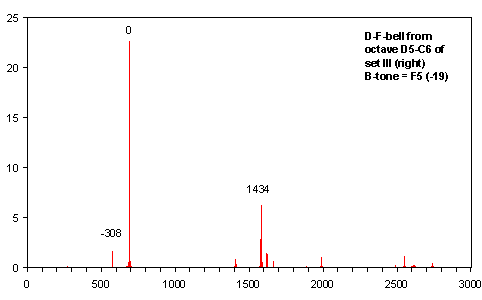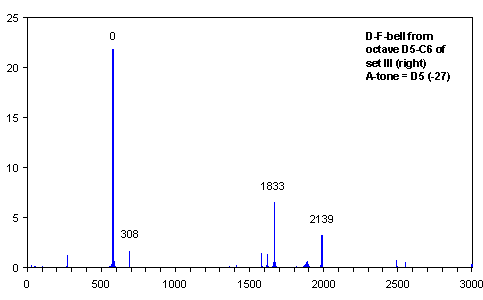
The two spectra are from the D-F bell of the octave D5-C6 of set III of the melody bells in the middle tier of the ensemble. It is the 7th bell from the right as seen on the pictures.
The A-tone (D5, blue spectrum) is produced by striking the bell, close to the rim, in the middle of either the front or the back face.
The B-tone (F5, red spectrum) is produced by striking the bell, close to the rim, in the middle of one of the four halves of the two faces.
The interval between the two fundamentals (0) is 308 Cent, which is close to the mathematically exact "minor third" (316 Cent, frequency ratio 6:5).

The spectra show that many of bell's vibration modes are excited by striking either A or B-tone. But the amplitudes of the vibration modes vary dramatically between A and B-tone. This is due to the different striking points, and it is further supported by the 36 bosses (nipples) on the upper parts of the bell's faces, 9 on each half-face. The result is that both pitch and timbre of the two tones are well separated. Intermediary striking points can of course mix them, giving a skillful player a wide range of options.
As opposed to European-style church bells and carillon bells, the perceived pitch is determined by the frequency of the most simple vibration mode that is acivated from the given strike point. Further, the pitch perception is not interfered with by the rest of the spectrum, which is only partly harmonic and never presents a series of partials.
Five other bells from the same set (III) were analyzed in the same way. They showed the same spectral characteristics. A modern replica bell (B4-D5) was analyzed by considering the frequencies of its main 30 vibration modes. This bell was precisely tuned to the international norm-tone scale (A4 = 440 Hz), and the minor third of the two fundamentals was 299 Cent, which is very exact according to the standards of equal temperament (300 Cent). Most probably, this bell had been fine-tuned electronically after casting. But, apparently, only the two fundamentals were fine-tuned. The other spectral components showed less harmonicity than in the original bells. For physical reasons, a thorough fine-tuning of the fundamentals is bound to reduce the overall harmonicity of the spectra. This could explain why the original bells sound more pleasant than the replicas. It would also be a compelling explanation why the bell casters of the original bells did not fine-tune the fundamentals to a high degree of scale perfection. They could have done this, because they had very precise string instruments for interval matching. However, considering both scale-tuning data and spectral-tuning data, they apparently aimed at a balanced compromise between acceptable pitches and pleasant spectra.